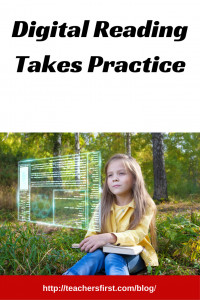 Most of us and our students spend a large part of each day reading digital text. Although we might prefer and encourage reading traditional print sources on paper, most of our future information needs will be fulfilled online. Although studies have shown people who read printed text comprehend more–thus learn and retain more, digital access to information on various electronic devices will continue to increase. Classroom teachers and library media specialists must understand the differences involved in reading multiple text formats. We need to give our students lots of practice in reading digitally, especially to help them deal with online distractions.
Most of us and our students spend a large part of each day reading digital text. Although we might prefer and encourage reading traditional print sources on paper, most of our future information needs will be fulfilled online. Although studies have shown people who read printed text comprehend more–thus learn and retain more, digital access to information on various electronic devices will continue to increase. Classroom teachers and library media specialists must understand the differences involved in reading multiple text formats. We need to give our students lots of practice in reading digitally, especially to help them deal with online distractions.
Here are a few articles that provide background on the topic.
- Naomi S. Baron, professor of linguistics at American University, has been researching this topic for several years. This article, Reading in a Digital Age, from Phi Delta Kappan, is an excellent summary of the issues. She discusses her research and others, suggesting “We need to ask ourselves how the digital mindset is reshaping students’ (and our own) understanding of what it means to read.” She called for additional studies on digital reading and its effects and role on writing.
- This article from the New Yorker Being a Better Online Reader by Maria Konnikova discusses some of the physiological research about digital reading and what researchers are developing to facilitate reading online print.
- Education Week devotes a special report to The Changing Face of Literacy, The report provides links to several articles that discuss digital versus print reading, the changing pedagogy for literacy and teaching reading, and the role of digital literacy in education.
- Ferris Jabr in the Scientific American article The Reading Brain in the Digital Age: The Science of Paper versus Screen asks, “How exactly does the technology we use to read change the way we read? How reading on screens differs from reading on paper is relevant not just to the youngest among us, but to just about everyone who reads.” The article shares research from the past twenty years, concluding that print text is perhaps the preferred and better way to read longer, complex texts. However, technology for reading digitally is continuing to evolve and improve. In the future, digital reading will dominate.
- A scholarly article with practice implications Digital Reading: Genre Awareness as a Tool for Reading Comprehension by Tanya K. Rodrigue, in Pedagogy, states, “To teach digital reading effectively, we need to start with a very basic question: how do students read?” The article goes on to share various methods used by the author. Most helpful is “Appendix 1: Digital Reading Toolbox Chart” that lists reading skills, teaching approaches and tools.
Now try a few tips to help students become better digital readers.
- This article found in Reading Rockets, Literacy Instruction with Digital and Media Technologies, shares a fourth-grade teacher’s experiences weaving the new literacy into the classroom.
- TeachThought discusses online tools to help students with close reading skills in this post, “Actually Achieving Close Reading With Digital Tools.”
- ReadWorks, reviewed on TeachersFirst, is “a free, research-based, and Common Core-aligned reading comprehension curriculum for grades K-6. Search through hundreds of lesson plans organized by grade level, topic, or book titles.”
- Rewordify helps with reading comprehension and is reviewed on TeachersFirst.
- Take out distractions with Chrome extensions. Although recently discontinued, I have used Clearly for years which removes ads and distractions making it both easier to read and providing a clean page for printing. Try this Chrome extension, Clear Read instead. Here are more suggestions for accessibility and differentiation by Eric Curts in his post Alternatives for the Clearly Chrome Extension.
- Provide differentiated digital reading practice in the classroom using one of these free resources below. Each has kid-friendly, interesting articles and various curricular enhancements, such as vocabulary, links, and quizzes. See the TeachersFirst reviews for additional ideas for classroom use.
- Newsela, TeachersFirst review
- Smithsonian’s TweenTribune and its K-4 companion, TT Junior, TeachersFirst review.
- DOGOnews, TeachersFirst review.

